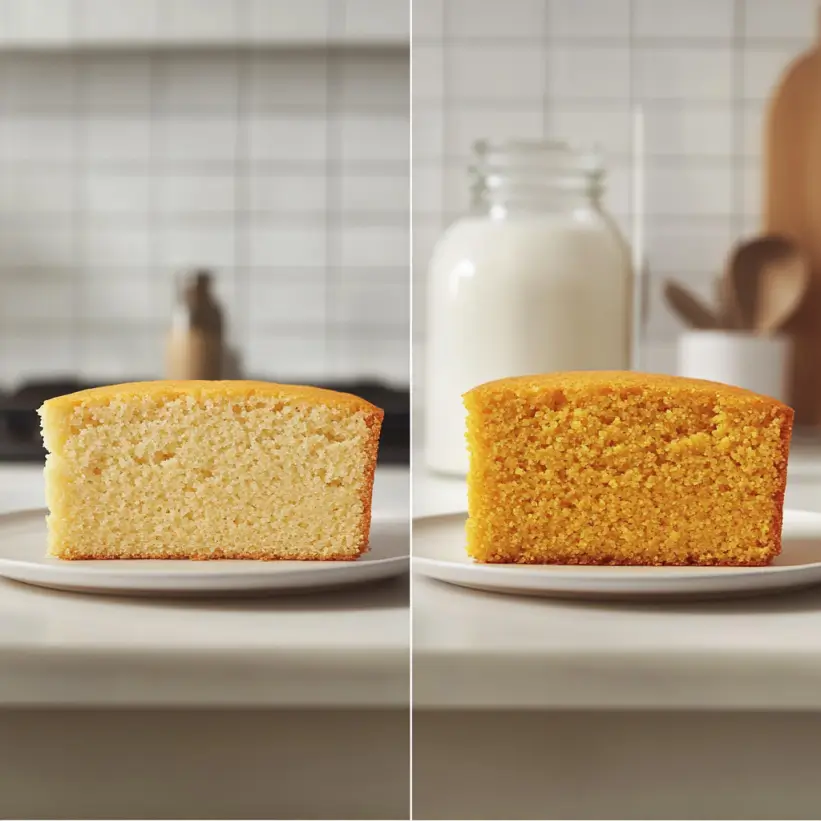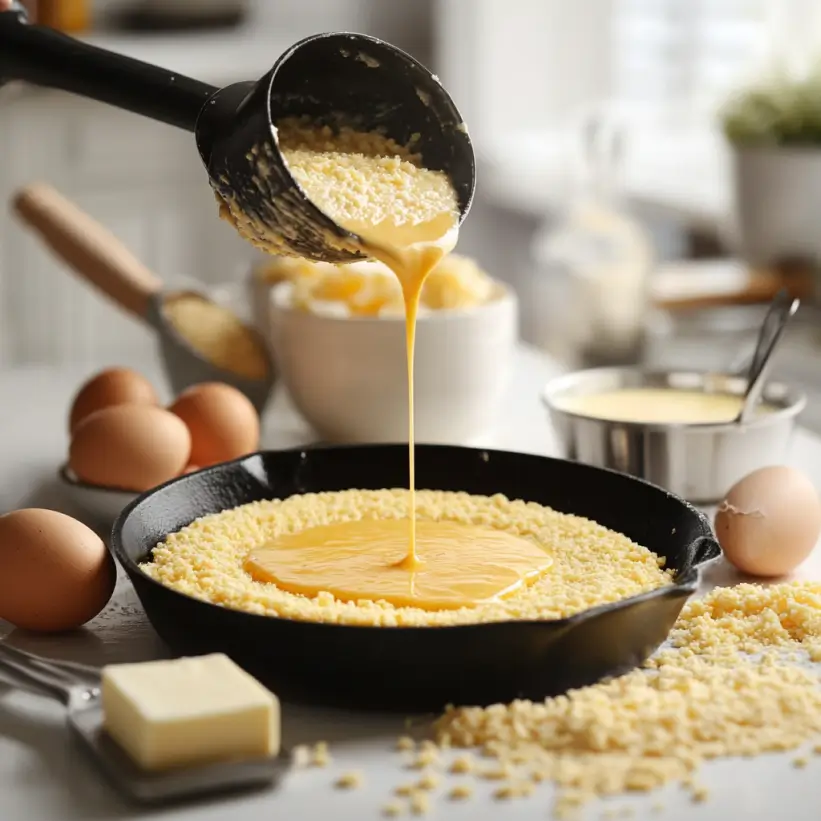Cornbread is a classic dish with a rich history, beloved for its versatility and comforting taste. However, when crafting the perfect batch, one question often arises: Is it better to use milk or buttermilk in cornbread? This article dives into the debate, exploring the role of each ingredient, their impact on flavor and texture, and how they align with regional preferences. By the end, you’ll have all the information you need to choose the right liquid for your cornbread recipe.
Table of Contents
Introduction to the Debate
Overview of Cornbread and Its Variants
Cornbread, a beloved staple in Southern and Northern cuisine, can vary widely in flavor, texture, and sweetness. Southern cornbread leans toward savory simplicity, while Northern versions often feature a touch of sweetness. What ties these variants together is their core ingredients—cornmeal, liquid, and a leavening agent.
The Historical Use of Milk and Buttermilk in Cornbread
Traditionally, buttermilk was the liquid of choice due to its availability and affordability in rural areas. Farmers often relied on buttermilk left over from butter churning to enrich their baking. Milk, on the other hand, became popular as industrialized farming increased access to fresh dairy products, offering a lighter, simpler alternative.
The Purpose of This Discussion: Milk vs. Buttermilk
Choosing between milk and buttermilk affects not only the cornbread’s flavor but also its texture and moisture. Milk produces a milder, less tangy loaf, while buttermilk adds richness, tenderness, and a hint of acidity. By comparing these options, we’ll uncover the best fit for different palates and recipes.
The Role of Liquid in Cornbread Recipes
Why Liquid is a Key Ingredient in Cornbread
Liquid is essential in any cornbread recipe. It acts as the binding agent that holds the batter together, allowing it to bake into a cohesive, fluffy bread. Whether you choose milk or buttermilk, this ingredient ensures the starch in the cornmeal absorbs moisture, creating a tender texture. Without enough liquid, cornbread can turn out dry and crumbly, which is far from ideal.
The Science Behind Milk in Baking
Milk is often used for its neutral flavor and ability to add moisture. In cornbread, it helps dissolve the sugar and salt, creating a balanced mix. Milk also contributes to the Maillard reaction, which gives baked goods their golden-brown crust. However, milk’s lack of acidity might make it less effective at activating baking soda compared to buttermilk, which could affect how much your bread rises.
How Buttermilk Impacts Texture and Flavor
Buttermilk, with its tangy taste, is a game-changer in cornbread recipes. Its natural acidity reacts with baking soda to produce carbon dioxide, leading to a lighter, airier bread. This reaction also enhances the bread’s tenderness, making each bite melt in your mouth. Additionally, buttermilk’s rich flavor pairs perfectly with the slightly sweet or savory notes of cornbread.
For an interesting twist, check out Simply Yummy’s article on how adding vanilla alters bread recipes, which highlights similar reactions in baking.
Benefits of Using Milk in Cornbread
Common Reasons to Choose Milk Over Buttermilk
Milk is a convenient and versatile choice for cornbread. It’s typically more affordable and readily available than buttermilk. For those who prefer a milder flavor, milk provides moisture without altering the bread’s classic corn flavor. Its neutral profile also makes it ideal for recipes where other flavors, such as herbs or spices, take center stage.
How Milk Affects the Texture of Cornbread
Milk produces a slightly denser cornbread compared to buttermilk. While it may lack the tangy zing, milk creates a crumb that’s still soft and satisfying. This makes it a great choice for pairing with soups or stews, as the denser texture holds up well when dipped.
The Flavor Profile When Using Milk
Cornbread made with milk tends to have a subtle, sweet undertone that complements honey, butter, or jams. If you enjoy a mild-tasting bread that lets the natural flavor of cornmeal shine, milk might be the better option.
For other baking tips, you can explore Simply Yummy’s article on how milk enhances scallop dishes, showcasing its versatile culinary applications.
Advantages of Buttermilk in Cornbread
Why Buttermilk is Often Preferred
When it comes to cornbread, buttermilk frequently takes the crown. Its rich, tangy flavor enhances the natural sweetness of the cornmeal, creating a well-rounded taste. Additionally, its acidic properties activate baking soda more effectively than milk, helping the bread achieve a light, fluffy texture. This quality makes buttermilk a favorite choice in traditional Southern cornbread recipes.
For more inspiration on working with buttermilk, consider exploring Simply Yummy’s article on how to use buttermilk for marinades to understand its versatility beyond baking.
The Moisture and Tenderness Buttermilk Adds
Cornbread made with buttermilk is known for its tender crumb and moist interior. The fats and proteins in buttermilk coat the cornmeal, preventing the bread from drying out. This quality is particularly important when you want your cornbread to complement heartier dishes like chili or barbecue.
Flavor Enhancements from Buttermilk
Beyond its functional benefits, buttermilk’s tang adds depth to cornbread. This acidity balances out sweeter recipes while amplifying savory ones, making it a versatile addition to both Northern and Southern-style cornbread. The result? A slice that’s satisfying on its own but also pairs beautifully with butter, honey, or jam.
If you’re curious about incorporating buttermilk in other recipes, check out Simply Yummy’s suggestions for classic Thanksgiving sides.
Regional Preferences and Traditions
Southern vs. Northern Cornbread: A Sweet and Savory Debate
Regional differences play a big role in the ongoing question: Is it better to use milk or buttermilk in cornbread? Southern-style cornbread is traditionally savory, relying on buttermilk for its rich, tangy flavor. Northern recipes, on the other hand, often include sugar and are lighter in texture, making milk a more common choice.
This divide isn’t just about taste—it reflects the history and culture of these regions. Southern cooks have long embraced buttermilk for its availability and ability to enhance hearty, savory dishes. Meanwhile, Northern recipes evolved to cater to sweeter palates, often pairing cornbread with honey or maple syrup.
Cultural and Historical Influences on Liquid Choice
The preference for milk or buttermilk also stems from historical factors. Early Southern settlers used buttermilk because it was a byproduct of butter churning and widely accessible. In contrast, Northern states had better access to fresh milk, influencing their cooking styles. These traditions persist today, influencing how cornbread is made and enjoyed across the United States.
For more regional cooking insights, consider browsing Simply Yummy’s collection of homemade bread recipes, which showcase similar cultural influences.
Side-by-Side Comparison: Milk vs. Buttermilk

Texture Differences
The debate over Is it better to use milk or buttermilk in cornbread? often centers on texture. Cornbread made with milk tends to have a slightly firmer, denser crumb, making it an excellent choice for dishes where structural integrity is key—such as cornbread stuffing or as a side for hearty soups. On the other hand, buttermilk produces a lighter, fluffier texture that almost melts in your mouth, perfect for standalone servings or with a spread of butter.
Flavor and Sweetness Variations
Milk offers a neutral base, allowing the cornmeal’s natural flavor to take center stage. This makes it ideal for recipes with added sweetness, such as Northern-style cornbread. Buttermilk, however, introduces a tangy complexity that enhances savory recipes. Its slight acidity balances the flavors, making buttermilk cornbread an irresistible companion to rich, meaty mains like chili or barbecue.
Which is More Versatile?
While milk might seem more adaptable due to its neutral flavor, buttermilk has a surprising range of uses. It pairs well with both sweet and savory dishes, thanks to its ability to complement and enhance other ingredients. For instance, using buttermilk in sweeter cornbread recipes can add depth without overpowering the sweetness. Ultimately, the choice comes down to personal preference and the dish you’re serving.
Tips for Adapting Cornbread Recipes
When to Substitute Milk for Buttermilk
If you’re out of buttermilk, don’t worry—you can still make delicious cornbread with milk. To replicate buttermilk’s acidity, simply add a tablespoon of lemon juice or vinegar to a cup of milk and let it sit for a few minutes. This quick fix preserves the light texture and tangy flavor typically associated with buttermilk cornbread.
Creating a Buttermilk Substitute

Another option is to use yogurt or sour cream thinned with a bit of water or milk. These substitutes maintain the moisture and richness that buttermilk brings to the table. Experimenting with these alternatives can also lead to exciting variations in flavor and texture.
Enhancing Recipes for Different Palates
To customize your cornbread, consider adding ingredients that complement your liquid choice. For milk-based recipes, honey or sugar can enhance sweetness, while buttermilk pairs beautifully with cheese, jalapeños, or fresh herbs. These small tweaks can make a big difference in flavor, ensuring your cornbread suits the occasion perfectly.
FAQs Section Based on Google’s “People Also Ask”
Is Buttermilk Healthier Than Milk in Cornbread?
When it comes to health, buttermilk has some benefits. It has less fat than whole milk and contains good bacteria that help with digestion. Milk, however, has important nutrients like calcium and vitamin D, which are good for strong bones. So, is it better to use milk or buttermilk in cornbread if you’re thinking about health? It depends on what you need. Buttermilk gives great flavor with fewer calories, making it a good choice for taste and health.
What Can I Use If I Don’t Have Buttermilk for Cornbread?
No buttermilk at home? No problem. You can easily make your own by mixing a tablespoon of vinegar or lemon juice with a cup of milk. Let it sit for a few minutes, and there you have it—instant buttermilk! This simple trick keeps your cornbread soft and slightly tangy, just like a recipe made with real buttermilk.
Can I Mix Milk and Buttermilk in the Same Recipe?
Sure! Mixing milk and buttermilk can create a good balance of flavor and texture. This is a great idea if you want the richness of buttermilk but need to use some milk to make it last. Trying out different amounts can give you new and tasty results.
Does Using Buttermilk Make Cornbread Fluffier?
Yes! The acid in buttermilk reacts with baking soda to create bubbles of air that help the bread rise. This is why buttermilk cornbread is often lighter and softer than cornbread made with milk.
Conclusion: Which is Better for Your Cornbread?
Summary of Milk and Buttermilk Benefits
So, is it better to use milk or buttermilk in cornbread? The answer depends on what you like and what you’re making. Milk has a mild taste, great for sweet or strongly flavored recipes. Buttermilk has a tangy flavor and makes softer bread, so it’s often used in classic Southern cornbread.
Final Recommendations for Choosing Ingredients
If you want fluffier, tastier cornbread, buttermilk is the better choice. But milk works well if you’re looking for something simple and easy. Can’t decide? Use both! Mixing milk and buttermilk can give you the best of both worlds. In the end, both work well, so it’s up to what you like and what goes with your meal.
For more ideas and tips, check out Simply Yummy’s recipes to inspire your next meal. Whether you use milk or buttermilk, warm cornbread is sure to bring a smile to your table. comfort and joy to your table.

